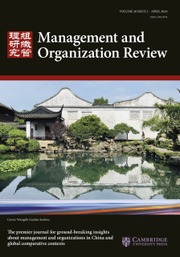No CrossRef data available.
Article contents
How Social Media Empowers Stakeholders: A Stakeholder Multiplicity Perspective
Published online by Cambridge University Press: 26 March 2025
Abstract
The literature shows that social media enhances individual stakeholders’ ability to directly influence firm behaviors, paying less attention to how it enables different stakeholder groups to influence firms collectively. Drawing on the stakeholder multiplicity perspective in stakeholder theory, this study theorizes and empirically demonstrates that social media can empower lower-salience stakeholders to drive the actions of higher-salience stakeholders to influence firm behaviors. By analyzing 506 consumer crises involving foreign and local companies in China from 2000 to 2020, we find that firms take more substantial responsibility when confronted with consumers’ social-media-based collective actions than when confronted with conventional channels of consumer complaints. This heightened responsibility stems mainly from collective actions’ tendency to spur law-enforcing agencies into addressing alleged firm misdeeds, demonstrating a stakeholder multiplicity effect of social media empowerment. We also identify the institutional contingency of this effect, showing that local governments’ bureaucratic capacity positively moderates collective actions’ effect on law-enforcing actions, whereas their intervention in firms’ operational decisions negatively moderates law-enforcing actions’ effect on firms’ responsibility assumption. This study extends the understanding of social media's relationship with stakeholder influence and consolidates the stakeholder multiplicity perspective in stakeholder theory.
摘要
文献表明,社交媒体能够增强个体利益相关方直接影响企业行为的能力,但较少关注社交媒体如何促使不同利益相关方群体共同影响企业行为。基于利益相关方理论中的“多元性视角”,本研究从理论和实证角度阐明了社交媒体能够赋权低显著性利益相关方,使其推动高显著性利益相关方采取行动,从而影响企业行为。通过分析 2000 年至 2020 年间涉及中国本土和外资企业的 506 起消费者危机事件,本文发现,与传统的消费者投诉渠道相比,当企业面对消费者基于社交媒体的集体行动时,会承担更多责任。这是因为基于社交媒体的集体行动更容易推动执法机构调查处理消费者所声称的企业不当行为。这说明了社交媒体赋权的“利益相关方多元性效应”。本文还识别了这一效应的制度促进因素和制约因素:地方政府的行政管理能力正向调节了基于社交媒体的集体行动对执法行为的影响,而地方政府对企业经营的干预程度则负向调节了执法行为对企业承担责任的影响。本研究扩展了对社交媒体与利益相关方影响之间关系的理解,并丰富和巩固了利益相关方理论中的多元性视角。
Keywords
- Type
- Article
- Information
- Copyright
- Copyright © The Author(s), 2025. Published by Cambridge University Press on behalf of International Association for Chinese Management Research


